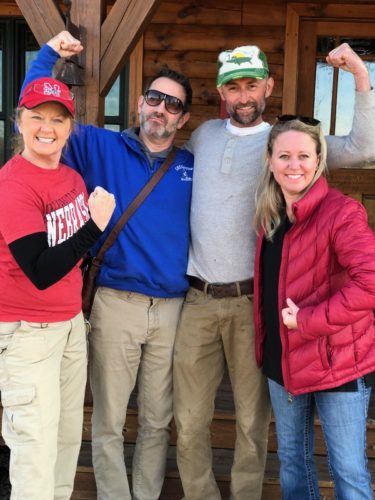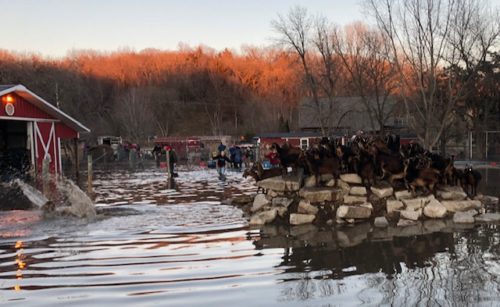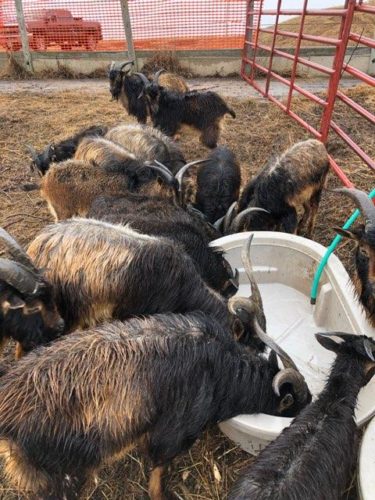Owners of San Clemente Island Goat Farm Highlight Role of Disaster Recovery
Gregory Wlasiuk – May 2, 2019
The recent flooding in Nebraska left owners John Carrol and Chad Wegener rushing to save the livestock on their 40-acre goat farm. These weren’t any ordinary goats, however. Willow Valley Farms is home to some 264 San Clemente Island Goats, one of rarest breeds of feral goats in the world.
John felt a connection to animals since childhood, avidly collecting magazines on exotic species and volunteering at the local zoo. Later he started his own hobby farm where he adopted a young San Clemente Island Goat among other rarities such as Emus. Between 1990 and 1997 he lived in LA and worked for HIV clinics at a time where nobody wanted to touch AIDS patients. He recalls that “the sanctuary I had, when I could be around the animals, was my safety spot.”
During this time John quickly formed a close bond with his goat, and the road leading to Willow Valley Farms was paved. “That little goat probably saved me as much I saved him.”
Hope Amid Destruction

(From left) Tracey, Chad, John, and Amber taking a break during recovery duties.
Saving these special animals during the Midwest Floods 2019 was no easy task as Willow Valley Farms boasts one of the largest populations of San Clemente Island Goats. Though there were some unfortunate casualties due to the violent weather and extreme stress during the rescue, nearly all the goats miraculously survived. John and Chad weren’t alone. WIFSS disaster training specialist Tracey Stevens along with UC Davis School of Veterinary Medicine alumni Dr. Amber Bowen helped in the effort to care for and find suitable shelter for these misplaced animals.
“I’ll never forget those first few days,” John said. “The whole community was involved. We had nurses there giving out shots. We had 50 people that came to get the goats out of the water and 50 people that showed up a week later to get them fully assessed, checked out, treated, DNA pulled – it was unbelievable.”
“We’ve been giving them good nutrition and a calm place to be,” Dr. Bowen said about the recovery efforts. “They are pretty hands-off goats. They’re not pets. I think it was a highly stressful time for them and just being able to be in a low stress environment where there isn’t a lot of people around was priority number one. Just being left alone was the best thing for them.”
The disaster and the ongoing recovery proved to be a learning experience for Chad and John, as well as the whole community. While there are still many hardships to overcome in the wake of the floods, the owners of Willow Valley Farms have also taken time to find what good can come from something so devastating. It provided an opportunity for the community to come together and help one another.
“It’s this weird dynamic,” John said. “We know how lucky we are and how much worse other people have it, and that gives us perspective. But we also have to allow ourselves to grieve. Chad and I built this farm together with friends and family over twelve years and in a matter of 48 hours everything that we knew to be true was swept away.”
“On this other side is this amazing amount of outreach and this new friendship with Amber and Tracey and all these other people. It’s a mind bend, because on one side you are grieving both for what’s happened and grieving for the loss of others, and on the other side all of this goodness and humanity just overwhelms you.”
Opportunities to Learn
The disaster also opened an opportunity to raise awareness for these unique goats. John and Chad are currently focusing on testing their goats to ascertain the purity of the breed, an important quality when it comes to preserving and protecting animals as rare as these. They are hoping to add their herd’s DNA to a database that would help map out a genome to identify what constitutes a genuine San Clemente Island Goat.

Goats rescued after being stranded in the flood.
“All of the attention these goats are getting right now never would’ve occurred but for the flood,” John noted. “The interest will wane to a certain point, so we can’t lose the opportunity we have here talk about this breed of goats, as well as talk about disaster planning: where are your animals going to go? How are you going to feed them? How are you going to provide medical treatment?”
“When the dust has settled and we get back to a sense of normalcy it’s important to not let the lessons we’ve learned escape us,” John explained. “We need to sit down and see what we can do so that we can tell a small farmer, whether they have goats, sheep, cows, or chickens, you have to have a disaster plan.”
Aid is Needed Long After a Disaster
While nearly all the goats were saved and finding appropriate shelter was successful, gathering adequate feed for the coming months was a different issue. Through donations were greatly appreciated, they quickly found themselves overwhelmed with a great variety of feed of varying quality. “It turns into a dumping ground,” Tracey commented. “The quality of hay was lacking for sure.”
This is a familiar scene in disaster recovery. Though the event may immediately bring together a community of volunteers and aid, this frequently dies off in the following months, often when those affected need it most. Usually donations arrive fast and plentiful in the immediate wake of the disaster, but the burden usually falls on the victims to sift through and find what is useful in a surplus of inadequate or sometimes unusable donations. To make things worse, in the weeks following a disaster, donations often drop off dramatically.
“The hay is going to run out. The donations that have been made are always during that first acute phase of disaster recovery,” John said.

One of the temporary shelters in place as recovery efforts continue.
“We’re hoping these donations last until the beginning of July so that our pastures will have enough growth by then that they can get back on our natural grazing land,” Chad added.
And while donations help, volunteering time and work is essential to any long-term disaster recovery effort. Often there isn’t enough people to help sort donations and keep track of preserving and organizing essential items such as quality feed.
“Donation management is needed. The hay, the alfalfa – if someone was out there tagging, dating, timestamping what was coming in, it would’ve been different,” Tracey said. “We loaded up what we were thinking was going to be a bonus, but when we unwrapped it yesterday the majority of it was molded.”
Chad and John are also fighting against those that seek to profit off the disaster.
“The price of Alfalfa has doubled,” Chad explained. “When you talk about after effects of a disaster, here you are. Farmers, or somebody buying all this alfalfa from farmers and maybe reselling it, are trying to capitalize. If it doesn’t get you one way, it will get you the other way if we run out of alfalfa.”
Preparing for the Future
WIFSS plays an important role in helping communities understand the long-term planning it takes for successful disaster recovery. Tracey Stevens teaches emergency preparedness to rural communities across the country and helped play a pivotal role in contacting Dr. Bowen as well as organizing disaster relief efforts for the floods.
Dr. Bowen, who graduated from UC Davis School of Veterinary Medicine in 2014, works with Tracy to inform disaster response trainings on the best practices for treating and handling animals during a disaster.
“After the California fires in 2017, Tracey is working with my own community in northern California to develop the Sonoma Community Animal Response Team. We are working hard so we can prepare, respond and recover from our next disaster. I love to see a community from another state like Nebraska that can also come together during an emergency, and I think this is where Tracey’s expertise and training is invaluable,” Dr. Bowen said. “Tracey is the reason that I ended up out there. It’s amazing how we could make a plan in 3 days, and treat 240 animals in just two days.”
“The flooding at Willow Valley Farms provides a unique case study for future trainings,” Tracey noted.
Chad, John, Tracey, and Dr. Bowen all hope to use this experience to expand perspectives on the successes they had, as well as improve on the hard lessons learned while preparing for long-term disaster recovery. While for the most part the response was successful, with the determination of Chad and John as well as the expertise of Tracey and Dr. Bowen, many rural communities don’t have these connections yet established, and need to know who to contact, or who can help, when a disaster strikes.
